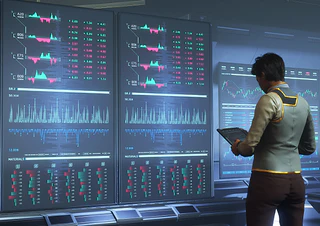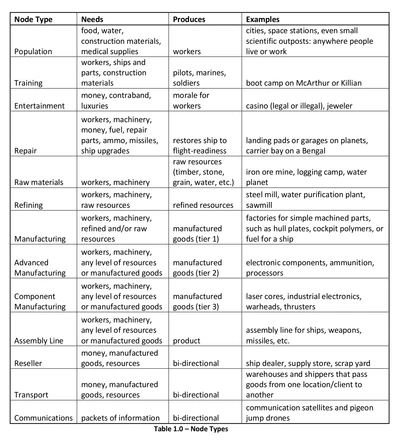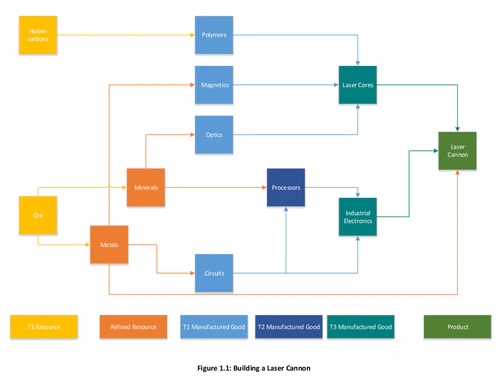
The economy is the movement of goods and currency throughout the system; facilitated by both players and NPCs alike. From raw materials to finished goods, players may step in at any time to set up their own business or trade.
The basic economy functions like a supply chain: Miners and other resource gatherers work to extract basic resources from the available supply, traders collect those goods and deliver them to other places, escorts protect those convoys from harm (while pirates attempt the opposite), refineries turn the raw goods into processed goods, and factories collect these processed goods to build the finished products that are in demand on worlds throughout the Star Citizen universe.[1]
Overall Economy Machine

The economy of star citizen is built to represent millions of entities that demand, produce, and transport resources and goods throughout the galaxy. This simulation is done by breaking down the economy into three discrete but connected parts:
- Nodes: Where goods are produced, stored, and demanded. Nodes may be as simple as a refinery or as complex as a population centre.
- Production Chain: The production chain is how nodes are connected to each other, beginning with raw resources and ending with a finished product
- Transportation: The actual movement of the resources and goods is handled by NPC- and player-controlled haulers and transports.
Nodes

Thousands of nodes make up the economy in Star Citizen, each requiring a certain input and producing certain outputs. Each node is made up of the following parts:
- Node Inputs: The types of things a node requires to operate
- Node Storage: How much of each input item or output item the node can store, directly affecting buying and selling prices
- Node Processing Capacity: Ability and effectiveness of turning inputs into outputs. Affected by number of workers, their happiness, and equipment quality
- Node Outputs: The produced goods [1]
Production Chain
The production chain is the sequence of parts that create a final product. Every product has some production chain that leads to its eventual production, involving raw materials, labour, and transportation.
Below is the production chain for a laser cannon, which requires some precise and expensive manufactured goods:
Transportation
To move these goods and parts around the galaxy, haulers and transports are necessary. These trade routes come in several forms, with varying levels of danger, pay, and consistency:[1]
- Trade lanes/routes: Consistent supply and demand between a producer and supplier. Often requires high volume transport at low rates. Only transporters and traders with a good reputation would be considered
- On-Demand: Consumers in dangerous space or with infrequent demand will put out trade requests and generally accept a contract with the lowest bidder; though reputation and past service will have an impact on this choice
- Emergency: Sudden shortages or major events create short-term, high-pay missions that are first-come, first-served.
The Player's Role
Whenever a player wants to enter the system, he will take the place of one of the AI. For instance, if a trader player wants to join in, then a trader NPC gets bumped out. It also means that the real players can't spike the economy: If there were 20 million AI agents running the universe and two million concurrent players online, then the players are only 10% of the actual population of that universe. They can affect some of the pricing, but they'll never be able to totally destroy the economy.[2]
The NPCs in Star Citizen will be able to fill any role in the economy, but players are able and encouraged to jump in and make their own paths and profits. Players can pick up transportation contracts in their armed Freelancer for a dangerous delivery, or buy out a production node and manage the inner workings of building laser cannons.[1]
At the most basic level players will be able to influence market prices and directly participate in the growth of cities, towns and outposts, by supplying goods in demand. Other players may wish to instigate blockades to cut off vital supply lines. Even without direct control of a factory or station, players will have many opportunities to impact the system.[3]
Development
The economy was first designed by using a boardgame designed by David Ladyman to test it out in broad strokes before putting in all the hours of programming each individual element.[4]
References
- ↑ Jump up to: 1.0 1.1 1.2 1.3 Comm-Link:The Star Citizen Economy. Engineering - Comm-Link
- ↑ GDC 2013: Chris Roberts expounds on Star Citizen's crafting, economy, Massively, Mar 30th 2013, archived
- ↑ David Ladyman, "The Economy, An Interview with Pete Mackay & Rob Irving". Jump Point. Vol. 01 no. 08. pp.28–32. Retrieved 2013-06-26.
- ↑ SCAA Interview with CIG's David Ladyman, Nichole D'Angelo, YouTube, 14 May 2014
